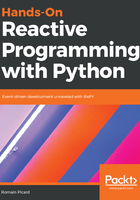
Introduction to ReactiveX and RxPY
ReactiveX is a library which aims to make asynchronous programming easy. As the header of the project's website says, it is: The Observer pattern done right
. ReactiveX is a library based on the idea of observable streams. A stream is an entity that emits zero, one, or several items, over a period of time. This stream of items can be observed by other entities that are interested in receiving these items and manipulated by them. This simple idea is the basis of what has become an incredibly successful way of doing asynchronous programming.
As said in the very first paragraph of this book, asynchronous programming is a very active field. ReactiveX is a typical example of technologies that did not exist a few years ago but that are now heavily used. It was originally one of the components of the Volta project at Microsoft. This project consisted of a set of developer tools to help with developing client and server parts of web applications. The Volta project was suspended in 2008 but ReactiveX continued to be developed, up to the point when it was publicly released for the .NET platform in 2010. The library was very successful, with a community starting to grow up and big companies such as Netflix and GitHub using it. In 2012, implementations for .NET, JavaScript, and C++ were published as open source projects. Since that time, ReactiveX has even impacted the standardization of some programming languages. ReactiveX now has official implementations for almost 20 programming languages and was the foundation of the Java reactive streams (http://www.reactive-streams.org) standard and the EcmaScript observable (https://github.com/tc39/proposal-observable) API. Nowadays, many other libraries, heavily inspired by ReactiveX, are available for virtually any programming language.
All of this is based on concepts that have already existed for many years, such as the observer design pattern, the iterator design pattern, and some principles from functional programming. The ingenuity came from combining them in such a way that it avoids the callback hell. Even better, it is equally suited for frontend applications that deal with user events and GUI widgets, and backend applications that work with network and database requests.